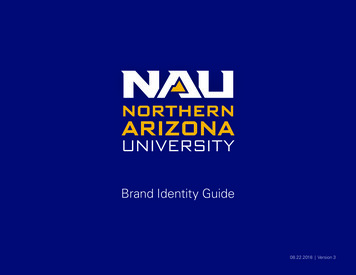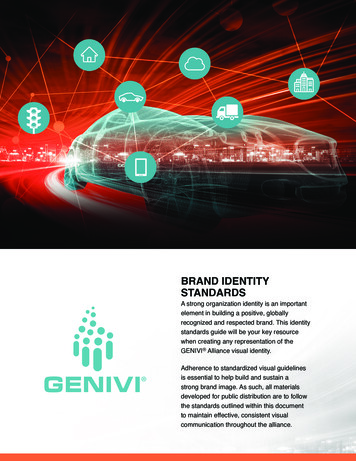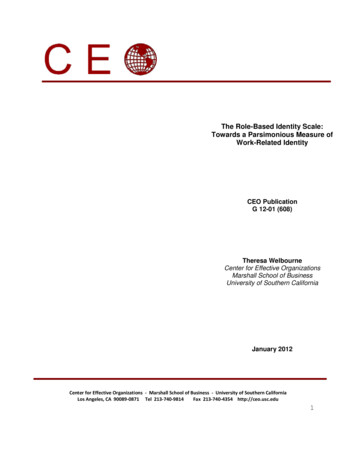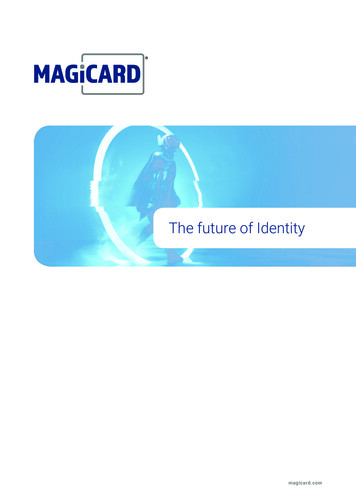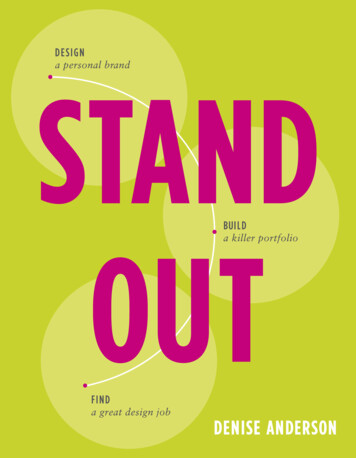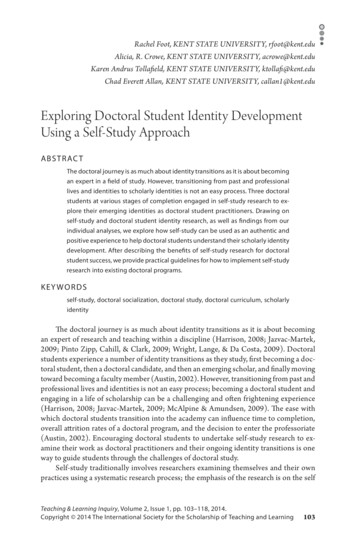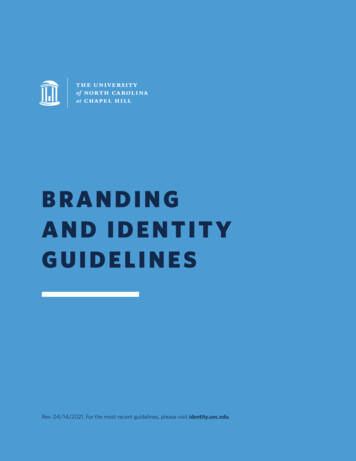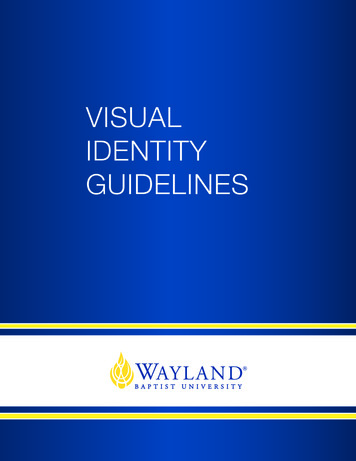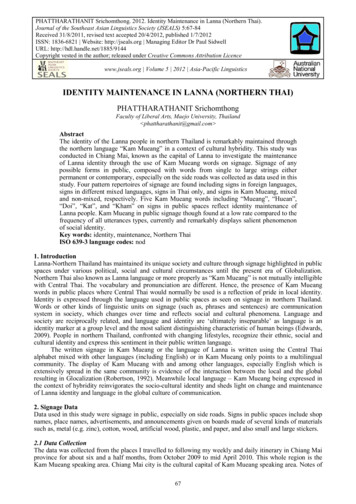
Transcription
PHATTHARATHANIT Srichomthong. 2012. Identity Maintenance in Lanna (Northern Thai).Journal of the Southeast Asian Linguistics Society (JSEALS) 5:67-84Received 31/8/2011, revised text accepted 20/4/2012, published 1/7/2012ISSN: 1836-6821 Website: http://jseals.org Managing Editor Dr Paul SidwellURL: http://hdl.handle.net/1885/9144Copyright vested in the author; released under Creative Commons Attribution Licencewww.jseals.org Volume 5 2012 Asia-Pacific LinguisticsIDENTITY MAINTENANCE IN LANNA (NORTHERN THAI)PHATTHARATHANIT SrichomthongFaculty of Liberal Arts, Maejo University, Thailand phattharathanit@gmail.com AbstractThe identity of the Lanna people in northern Thailand is remarkably maintained throughthe northern language “Kam Mueang” in a context of cultural hybridity. This study wasconducted in Chiang Mai, known as the capital of Lanna to investigate the maintenanceof Lanna identity through the use of Kam Mueang words on signage. Signage of anypossible forms in public, composed with words from single to large strings eitherpermanent or contemporary, especially on the side roads was collected as data used in thisstudy. Four pattern repertoires of signage are found including signs in foreign languages,signs in different mixed languages, signs in Thai only, and signs in Kam Mueang, mixedand non-mixed, respectively. Five Kam Mueang words including “Mueang”, “Huean”,“Doi”, “Kat”, and “Kham” on signs in public spaces reflect identity maintenance ofLanna people. Kam Mueang in public signage though found at a low rate compared to thefrequency of all utterances types, currently and remarkably displays salient phenomenonof social identity.Key words: identity, maintenance, Northern ThaiISO 639-3 language codes: nod1. IntroductionLanna-Northern Thailand has maintained its unique society and culture through signage highlighted in publicspaces under various political, social and cultural circumstances until the present era of Globalization.Northern Thai also known as Lanna language or more properly as “Kam Mueang” is not mutually intelligiblewith Central Thai. The vocabulary and pronunciation are different. Hence, the presence of Kam Mueangwords in public places where Central Thai would normally be used is a reflection of pride in local identity.Identity is expressed through the language used in public spaces as seen on signage in northern Thailand.Words or other kinds of linguistic units on signage (such as, phrases and sentences) are communicationsystem in society, which changes over time and reflects social and cultural phenomena. Language andsociety are reciprocally related, and language and identity are ‘ultimately inseparable’ as language is anidentity marker at a group level and the most salient distinguishing characteristic of human beings (Edwards,2009). People in northern Thailand, confronted with changing lifestyles, recognize their ethnic, social andcultural identity and express this sentiment in their public written language.The written signage in Kam Mueang or the language of Lanna is written using the Central Thaialphabet mixed with other languages (including English) or in Kam Mueang only points to a multilingualcommunity. The display of Kam Mueang with and among other languages, especially English which isextensively spread in the same community is evidence of the interaction between the local and the globalresulting in Glocalization (Robertson, 1992). Meanwhile local language – Kam Mueang being expressed inthe context of hybridity reinvigorates the socio-cultural identity and sheds light on change and maintenanceof Lanna identity and language in the global culture of communication.2. Signage DataData used in this study were signage in public, especially on side roads. Signs in public spaces include shopnames, place names, advertisements, and announcements given on boards made of several kinds of materialssuch as, metal (e.g. zinc), cotton, wood, artificial wood, plastic, and paper, and also small and large stickers.2.1 Data CollectionThe data was collected from the places I travelled to following my weekly and daily itinerary in Chiang Maiprovince for about six and a half months, from October 2009 to mid April 2010. This whole region is theKam Mueang speaking area. Chiang Mai city is the cultural capital of Kam Mueang speaking area. Notes of67
PHATTHARATHANIT Srichomthong Identity Maintenance in Lanna (Northern Thai) JSEALS 5 (2012)written signage data together with some hundreds of photos were collected from the Mueang district, or thecity of Chiang Mai, and seven other districts including Chom Thong, Doi Lo, San Pa Tong, Hang Dong, SanSai (especially at Mae Jo, its sub-district), Mae Rim and Chiang Dao. These are all smaller towns andmunicipal areas near to Chiang Mai City and still in Chiang Mai Province.2.2 Data Analysis: Types and Characteristics of SignageThe data of single to large strings of linguistic units, that is from words to sentences of both permanent andcontemporary types of signage were analysed by classifying all signs into types, and contrasting them innumber and percentage. The most frequently used signs in Lanna language or “Kam Mueang” were takeninto consideration.Signs found in this study were those of both permanent and temporary types. Place names andbusiness shop names were permanent, whereas most of the advertisements and announcements weretemporary. The former type could be made of metal (e.g. zinc), wood, artificial wood and plastic, whereasthe later of cotton, paper, plastic, and artificial wood, and also small and large stickers.Signs were written in Thai (the official language of Thailand), English, and other languages, such asChinese, Japanese, French and German. Some signs were given in two languages, mostly Thai and English.A mix of two, and even three languages were found on only one sign.Linguistic units in several languages used on signage ranged from single to large strings, that is, word,phrase and sentence, as shown below.Single words:ซาว saw ‘twenty’หมวย mǔaj ‘a female’s name’Phrases :บ � ้มพญาการ์เด ้นโฮมtime)’bānhāukaːraːɁoːkèɁ ‘our home karaoke’khúmphàʔɲaːkaːdênhom ‘residence of the great head of state ใหม่ ต ้องมาไนท์ซาฟารี maːɁӕ̀ ːwʨhiaŋmàitɔ̄ŋmaːnáitsaːfaːriː‘when (you) Visit Chiang Mai, you must visit Night Safari’Signs were classified into four types including signs in foreign languages, signs in different mixedlanguages, signs in Thai only, and signs in Kam Mueang, mixed and non-mixed3. Contrastive Use of All SignsThe total number of 3,825 signs was classified by way of contrast and four types of frequencies were found.Signs in foreign languages were used the most frequently, 31.00 %, mixed signs followed with littledifference, 29.52 %, Thai signs were used 26.64 %, or 4.36 % less than the highest number of all used signs,and Kam Mueang signs were used the least, 12.84 %, or 18.16 % less than the highest use, respectively. Thepie diagram below shows the contrastive use of all signs in this study.Figure 1: Contrastive use of all signs68
PHATTHARATHANIT Srichomthong Identity Maintenance in Lanna (Northern Thai) JSEALS 5 (2012)3.1 Signs in foreign languagesSigns in foreign languages, which were found most frequently among all types of signage, and wereclassified into three types including 1) signs in foreign languages in Thai (with and without Englishtransliteration), 2) signs in English only, and 3) signs in other languages.3.1.1 Signs in foreign languages in Thai with and without English transliterationSigns in foreign languages in Thai were divided into two types, exemplified as shown below, including signsin foreign languages in Thai without English transliteration, and signs in foreign languages in Thai withEnglish transliteration. Most words were from English; a few other languages appeared, including Chineseand Japanese.1) Signs in foreign languages in Thai without English transliteration:โค ้ก kóːk ‘Coke’แลนด์ แอนด์ เฮาส์ lӕːɁӕ̀ ːnháu ‘Land and House’ฟูจซิ งั ซูช ิ fuːʨìɁsaŋsuːʨhíɁ ‘Fujisang Shushi’2) Signs in foreign languages in Thai with English transliteration.It is noted that signs in English characters were obviously given, whereas most of signs in Thai characterswere much smaller in size.L Top Salon แอล ท็อป �็ต COWBOY’S MARKETThe Airport Greenery �อรี)Figure 2: L Top Salon แอล ท็อป ซาลอนFigure 3: คาวบอยมาร์เก็ต COWBOY’S MARKET3.1.2 Signs in English onlySigns in English only, that is, without Thai transliteration, have increased more and more in public. Englishnames for business shops (shop, hotel, restaurant, coffee shop, etc.), advertisements, and announcements arefound in English everywhere. Some data examples are given below.Bake &BiteMcDonald’sNatural Wellness Resort and SpaTaxi Services To Every WhereHANA CHRISTIAN International KindergartenYour car we care69
PHATTHARATHANIT Srichomthong Identity Maintenance in Lanna (Northern Thai) JSEALS 5 (2012)3.1.3 Signs in other languagesSigns in other languages including Chinese, Korean, Japanese, French, and German were recognized. Theywere written in those languages’ characters and sometimes accompanied with transliteration in Thai, andEnglish words.) จือIn Chinese: เจ ʨeː ‘vegetarian food’, ฮัน กง (with Chinese characters) hânʨɯ̂ ːkoŋ ‘Han Jue Kong – aname‘, ชุนเส็ง (without Chinese characters) ʨhunsěŋ ‘Chun Seng – a name’In Korean:In German:In Japanese:In French:Kanzen-KenkoBosch (Service), HÄFELE, Osram, Würth, Hofmann, Schenkerซูช ิ ไคโซ suːʨhíɁkhaisoː ‘Sushi Kai So’, TOYOTA, IsuzuCARREFOUR, Amitie Figure 4: HÄFELEFigure 5: CARREFOUR3.2 Signs in different mixed languages: Thai mixed with other languagesTwo types of mixed signs were found, 1) signs in a mix of Thai and English, which was the most dominantmixing, and 2) signs in a mix of Thai and other languages.3.2.1 Signs in a mix of Thai and EnglishThe mix of words on signage which was found most frequently among all types of mixing was the mixbetween English and Thai. These signage words were sometimes accompanied with English transliterations.1) The mix written in Thai with English transliteration:อินทนนท์รเิ วอร์ไซด์รสี อร์ท INTHANON RIVERSIDE RESORTแว่นบิวตีฟ ลู Beautiful Optical่ �รี Welcome to Chiang Mai Night Safariยินดีต ้อนรับสู Figure 6: อินทนนท์รเิ วอร์ไซต์รสี อร์ท INTHANON RIVERSIDE RESORT2) The mix written in Thai without English transliteration:70
PHATTHARATHANIT Srichomthong Identity Maintenance in Lanna (Northern Thai) JSEALS 5 (2012)อินทนนท์คอฟฟี) โรดɁinthanonkhᴐ́ffîːrót ‘Inthanon Coffee Road’แจ่มฟ้ าซุปเปอร์มาร์ทʨæ̀ mfáːsúppǝ̂ːmàːt ‘Chaem Fa Supermart’บ ้านรุง่ เรือง ควอลิตเี ฮาส์ bāːnrûŋrɯŋkhɔːlíɁtîːháu ‘Ban Rung Rueang Quality House’3) The mix written in Thai and EnglishThis type of mixing was given in Thai and English alphabet together on the same signage. Data examples areshown as in the following.ร ้านแว่นตา I LOVE U OPTICAL ráːnwæːntaː I LOVE U OPTICAL ‘I LOVE U Optical shop’Dr. com ซ่อมคอมฯ อัพเกรด Dr. com sɔ̂ːmkhɔːmʔápkrèːd ‘Dr.com repair & upgrade computer’เชียงใหม่ 89 plaza ʨhiaŋmài 89 plaza ‘Chiang Mai 89 plaza’Figure 7: ร ้านแว่นตา I LOVE U OPTICAL ráːnwæːntaː I LOVE U OPTICAL ‘I LOVE U Optical shop’4) The mix written in English, with or without Thai transliterationThe Nature Home ChiangmaiCENTRAL AIRPORT PLAZALight up your world to over 70 cities with THAIFigure 8: The Nature Home ChiangmaiFigure 9: Light up your world to over 70 cities with THAI3.2.2 Signs in a mix of Thai and other languages: Chinese, Japanese, Italian, French, and GermanFollowing are some data excerpts shown the mix between several other foreign languages except English insigns.Japanese Thai:จูลง่ สุก ี & กุ ้งกระทะ ʨuːlôŋsùʔkîː & kûŋkràʔtháʔ ‘Chulong shuki & pan grilledscrimp’วาซาบิแม่โจ ้ waːsaːbìʔmæ̂ ːʨôː ‘Maejo wasabi’Japanese English:Italian Thai:French Thai:ฮิตาชิแฟร์ 2010 híʔtaːʨhíʔfæː 2010 ‘Hitachi Fair 2010’สปาเก็ตตีข เี มาหมู sàʔpaːkéttîːkhîːmaumǔː ‘Spaghetti with spicy pork’Le โค ləːkhoː ‘the buffalo’, กุลพันธ์วลิ ล์ kunlaphanwil ‘Kulpan Ville’Chinese Thai:71
PHATTHARATHANIT Srichomthong Identity Maintenance in Lanna (Northern Thai) JSEALS 5 (2012)German Thai:Würth �ัน Würth théknoːloːjiːʨàːkjəːraman ‘Würth Technologyfrom Germany’3.3 Signs in Thai onlyMost signs in Thai only can be considered “old fashioned” or not-up-to-date. The material of those signslooks old; the words on such signage were written a long time ago as seen in the following �) ม่สบู บุหรี)รัตนผลsàɁràɁuː ‘vowel /uː/’khɔːpkhunthîːmâisùːbbùɁrìː ‘Thank you for not smoking’ráttàɁnáɁphǒːn ‘Rattanapol’Although many signage words look old fashioned, they have English translation as shown in a few examplesbelow.เปิ ด ��ตําบลจอมทองChom Thong FOOD CENTERSome shop names’ signs connote the owners and location of the shops, as seen in the excerpts given below.เกรียงไกร kriaŋkhrai ‘Kriangkrai’แม่โจ ้เภสัช mæ̂ ːʨôːpheːsàt ‘Mae Jo Pharmacy’ชาญชัยʨhaːnʨhai ‘Chanchai’Figure 10: เกรียงไกร kriaŋkhrai ‘Kriangkrai’A few Thai signs were written in English, that is, without Thai alphabet at all as shown in thefollowing data excerpts.Baan Thapae ‘Tha Pae house’ (a shop)SAMART ‘Samart’ (a television satellite product’s name, which can be translated as ‘be able’)Figure 11: Baan Thapae ‘Tha Pae house’ (a shop)72
PHATTHARATHANIT Srichomthong Identity Maintenance in Lanna (Northern Thai) JSEALS 5 (2012)3.4 Signs in Kam Mueang, mixed and non-mixedKam Mueang in this study meant only those signs that are written in Thai alphabet involving original soundsas much as possible. In the case of mixing, signs in Kam Mueang are mostly mixed Thai and English, only afew with French. Three types of signs in Kam Mueang are found on signage.3.4.1 Signs in Kam Mueang mixed with ThaiKam Mueang words written in Thai alphabet are mixed with Thai in various situations and places, bothpermanent and contemporary signage. Some excerpts of underlined words below are Kam Mueang.เฮือนสบู่hɯansàɁbùː ‘house of soap’กาดฝรั)งkāːtfàɁrāŋ ‘Market of Foreigners’กาดไม ้ริมคลองkāːtmáirimkhlɔːŋ ‘Wood market on the canal’เชียงใหม่ ฮอด ดอยเต่า อมก๋อยʨhiaŋmài hɔ̂ːt dɔːjtāu Ɂomkɔ̌ːj ‘Chiang Mai Hot Doi Tao Om Koi’ั ปี7 ��่ ǐːʨiaŋmāimûnʨǎihábpǐːmāimɯaŋ ‘Chiang Mai Honourable ObjectsFestival, welcome to Mueang New Year with Joy’มหกรรมผ ้าฝ้ ายตอมือ ๑๐๙ ปี7 ของดีจ๋อมตอง ครัง ตี ๓máɁhàɁkamphāːfāitɔːmɯː 109 pǐː khɔ̌ːŋdiːʨɔ̌ːmtɔːŋ khráŋtîːsǎːm ‘The Third 109 Years of ChomThong Hand-Woven Cotton Festival’3.4.2 Signs in Kam Mueang mixed with foreign languagesMueang words on signage are mixed with foreign languages, mostly with English. A few are mixed withChinese, French, Japanese, and Korean. Some mixes between Mueang and foreign languages mentioned arewritten in Thai alphabet only, some are written in Thai and English alphabet together, and a few are writtenin English only. Some excerpts of underlined words in the examples below are in Kam Mueang.Examples of Kam Mueang mixed with English:BCC ANTIQUES 1976 Ban Chang Come“Come”, that is “Kham – gold” combined as an adjective with Chang ‘elephant’ to mean ‘goldenelephant’บ ้านไม ้คํา Restaurantbâːnmáikham Restaurant ‘Golden house �� แอร์เอเชีย binmûantǽːkàbɁæːɁeːʨhia ‘Fly joyfully with Air Asia’แมนๆ ใจ๋ ๆหือ เปื อนมดเลย mæːnmæːnʨǎiʨǎi hɯ̄ ːpɯ̂ ːnmótlǝːj ‘The whole Gentlemen’s heart forfriends’ดอกเอือ งบานทีก) าดจริงใจ เจเจมาร์เก็ต dɔ̄ːkɁɯ̄ Orchids shown at Kat Ching Chai JJ Market’เชิงดอย OPEN CUP ʨhə̄ːŋdɔːi (foot hill) OPEN CUP ‘Foot hill open cup’Examples of Mueang mixed with French:Cafe de Klang Wiang (“Klang” ‘middle’; “Wiang” ‘capital’) ‘Coffee shop at the city center’เลอกองคํา ləːkɔːŋkham ‘Le Kong Kham’ (“Kham” ‘gold’)An example on Mueang mixed with 7 วเรือ ข ้าวซอย ɁàɁjútthajaːkǔajtǐawrɯa khāusɔːj‘noodle on boat in Ayutthaya’s style and Khao Soi’“Kuay Tiaw” are originally Chinese noodle dishes. “Khao Soi” is a popular dish in northern Thailand, madeof yellow noodles with rich milky curry. It was a Muslim dish and was introduced by the Chinese Muslimsknown as Ho in Thailand (Rattana, 1999) and Hui in Yunnan China.An example on Mueang mixed with Japanese:บ ้านเฮาคาราโอเกะ bāːnhaukhaːraːɁoːkèɁ ‘Ban Hau (our house) Karaoke’An example on Mueang mixed with Korean:73
PHATTHARATHANIT Srichomthong Identity Maintenance in Lanna (Northern Thai) JSEALS 5 (2012)ร ้านคังเซน –เคนโก ้-หลิงมืน) ráːnkaŋseːnkheːnkôːlìŋmɯ̂ ːn ‘Kanzen-KenkoLing Muen’(Ling Muen is an area in a sub-district of San Sai district)3.4.3 Signs in Kam Mueang, non-mixedThe words of the type “Mueang’ only refer to those that are written in Thai alphabet and can be pronouncedas the original Kam Mueang sounds. Some excerpts show Kam Mueang only on signage, which are used asshop names, products and also in temporary signage as announcements. Two photographs below areexamples of Kam Mueang signs.ข่วงบ ้านkhūaŋbāːn ‘house’s �ːk ‘flowery silverware nmæ̂ ːkhamphǒŋ ‘house of Mrs. Kham Phong’เฮือนนํ าปิ งhɯannǎːmpiŋ ‘house of Ping River’ไส ้อัว) ป้ าคําsāiɁùapāːkham ‘Aunt Kham Sai Ua’1ม่วนกัน7 หน ้ากาด mǔankǎnnāːːkāːt ‘be joyful in front of the market’ดีใจ๋ยงิ) แล ้ว แขกแก ้วมาเยือน บ่ลมื บ่เลือน เตือนกัน7 บ่เมาdiːʨǎijîŋlǽːw khǣːkkǣːwmaːjɯan bɔ̄ːlɯ̄ ːmbɔ̄ːlɯ̄ an tɯ̄ ankǎnbɔ̄ːmau‘(We) are so pleased that honourable guests come to visit us, please remind ourselves not to get drunk’สืบฮีต สานฮอย ผ่อกอย ป๋ าเวณีป7ี ใหม่เมืองหางดงsɯ̄ ːbhîːt sǎːnhɔːi phɔ̄kɔːi pǎːweːniːpiːmāimɯaŋhǎːŋdoŋ‘extend the rite, maintain traditional New Year festival of Hang Dong’ต๋ามฮีต ต๋ามฮอย ต๋ามผ่อ ต๋ามกอย ปี7 �ːmhîːt tǎːmhɔːi tǎːmphɔː tǎːmkɔːi pǐmāimɯaŋʨɔ̌ːmtɔːŋ‘Follow the rite, come maintaining traditional New Year Festival of Chom Thong’Figure 12: สะหลุงดอก sàɁlǔŋdɔ̄ːk ‘flowery silverware bowl’1“Sai Ua” is spicy Northern Sausage, roasted sausage made from pork and spices.74
PHATTHARATHANIT Srichomthong Identity Maintenance in Lanna (Northern Thai) JSEALS 5 (2012)Figure 13: ดีใจ๋ยงิ) แล ้ว แขกแก ้วมาเยือน บ่ลมื บ่เลือน เตือนกัน7 บ่เมา diːʨǎijîŋlǽːwkhǣːkkǣːwmaːjɯan bɔ̄ːlɯ̄ ːmbɔ̄ːlɯ̄ an tɯ̄ ankǎnbɔ̄ːmau‘(We) are so pleased that honourable guests come to visit us, please remind ourselves not to get drunk’4. The Contexts of The Five Most Frequent Use of Kam Mueang Word Elements“Mueang” (regional inhabitants), geographic settlement/location in “Doi” (mountain), symbolic prestige offinancial status on place of living in “Huean” (house), local market as trading place as well as place of socialinteraction in “Kat” (market), and social norm on precious thing in “Kham” (gold). Five most frequent use ofKam Mueang word elements according to the contrastive analysis of all Kam Mueang word elements in thisstudy include เมือง /mɯaŋ/ ‘regional inhabitants’ (61 times), ดอย /dɔːi/ ‘mountain’ (50 times), เฮือน/hɯan/ ‘house’ (40 times), กาด /kāːt/‘market’ (39 times), and คํา /kham/ ‘gold’ 38 times, respectively. Thetable below shows the statistic frequency of use of those five Kam Mueang word elements.Word Elementsเมือง mɯaŋ(61)ดอย dɔːi(50)เฮือน hɯan(40)กาด kāːt(39)คํา 4285123Precious things----15Word elementContexts4.1 Contexts of the use of เมือง /mɯaŋ/The word element “MUEANG”/mɯaŋ/ used in the context on characteristics of several things was found themost frequently, that is, 42 out of 61 times. “เมือง” /mɯaŋ/ is used in the context of place, language, andcharacteristics of several things. This highest and widespread use of “MUEANG” /mɯaŋ/ shows the prideof local inhabitants in holding onto their prestigious social status. “Khon” means people and “Mueang”specifies those people who are civilized and live in the city (Udom, 2006) “Khon Mueang” formerly referredto the local people, who were distinguished from Burmeses during the Burmese occupation for about twohundred years in the past and were called “เมือง” /mɯaŋ/ (Sanguan, 1969: 189 – 190). Kam Mueangbelongs to the Tai language family (Diller, 1990), whereas Burmese belongs to Tibeto-Burman languagefamily (Suriya, 1988). However, during Burmese’s occupation (1558 – 1777), some Burmese words wereborrowed, such as ปอย /pɔːi/ ‘fair or celebration’, which was borrowed from /pæːw/ and กะบอง /kàɁbɔːŋ/from /pauʨɔ̀ː/ which means fried pieces of pumpkin mixed with flour (Udom, 2004), แกงฮังเล or แกงฮินเล/kæːŋhaŋleː/ or /kæːŋhinleː/ ‘Hungle curry - a spicy and fatty pork curry’ and /náːmphríkɁɔ̀ːŋ/ ‘chili pastewith chopped pork and tomatoes’ (Sanguan, 1969).Because central education mandates the use of central Thai in all school education as the medium ofinstruction, many local people have begun to replace commonplace words, such as /tēːw/ with /kǎːŋkěːŋ/‘trousers’ when people speak Kam Mueang. In the last decade, Kam Mueang courses have been offered inuniversities, such as Chiang Mai University, Maejo University, Rajabhat Chiangmai University, and selected75
PHATTHARATHANIT Srichomthong Identity Maintenance in Lanna (Northern Thai) JSEALS 5 (2012)schools and at local temples such as Wat Suan Dok, and a few isolated local groups throughout northernThailand (Chayutpat – oral primary source, 2012). A group of people are hoping to provide teaching of KamMueang in primary schools in northern Thailand. There has also been a resurgence of Lanna identity asdemonstrated by wearing of “Mueang” style clothes at special festivals and on every Friday in schools,universities, government offices and banks, and by practice of rites and decorations on festival occasions.These innovations appear to be gathering momentum and can be regarded as signs of success in theresurgence of Lanna Identity. If the promotion of Kam Mueang in schools succeeds, the Lanna identityshould be assured in the era of globalization.In the context of use of Mueang, the word element /mɯaŋ/ is used as an adjective in a combination toform compound nouns, as in the following examples.มาแอ่วงาน บ่ดลี มื แต่งชุดพืน เมืองมาตวย รางวัลเครือ) งแต่งกาย ยังรอท่านอยู่ เน ้อเจ ้าmaːɁǣːwŋāːn ːj raːŋwankhrɯ̂ atæːŋkaːj jaŋrɔːthâːnjuːnə̂ːʨâu‘Joining the party, please do not forget to dress in local suits, dressing award is waiting for you’ของกีน7 คนเมือง khɔ̌ːŋkǐːnkhonmɯaŋ ‘“Khon Mueang”- local food’The most frequent use of the word element “Mueang” is incorporated with the word ปี7 ใหม่ /pǐːmai /‘New Year’ to be “ปี7 ใหม่เมือง” /pǐːmaimɯaŋ/ ‘Northern Thai New Year, or New Year of Khon Mueang’among the elements /mɯaŋ/ “MUEANG”, which is used 18 times out of 42. That is one-third of its use inthe earlier mentioned contexts. The use of the element /mɯaŋ/ found in “contemporary” signage, is oftenused before and during the period of “ปี7 ใหม่เมือง” /pǐːmaimɯaŋ/ or “Song Kran” festival, that is traditionalNew Year. This popular use indicates that “Khon Mueang”, people of the North, value traditional Thai NewYear as the most important custom or rite. /pǐːmaimɯaŋ/ ‘Mueang-Northern Thai New Year Festival’ hasbeen the most cherished occasion for all families. It’s a time for great making-merit at the temple, showingrespect to the elderly relatives who give traditional wishes in return. Traditionally typical things such asfood, utensils and dress, are used to celebrate, and extend good wishes for the coming “new” year. Somecontemporary signs show the extensive use of “ปี7 ใหม่เมือง” pǐːmaimɯaŋ ‘Mueang-Northern New YearFestival’.Examples:ตามฮีต ตวยฮอย ป๋ าเวณีป7ี ใหม่เมืองฮ่วมกัน7 สรงนํ าพระtaːmhîːt tuajhɔːi áɁ‘Following the rite, following “Mueang” New Year Festival, please spring water to the statue of Buddhatogether’ต๋ามฮีต ต๋ามฮอย ต๋ามผ่อ ต๋ามกอย ปี7 ใหม่เมืองจ๋อมตอง tǎːmhîːt tǎːmhɔːi tǎːmphɔː tǎːmkɔːi pǐmāimɯaŋʨɔ̌ːmtɔːŋ ‘Following the rite, following Chom Thong New Year Festival’ป๋ าเวณีป7ี ใหม่เมือง pǎːweːniːpǐːmaimɯaŋ Chiang Mai Song Kran Festival ‘Chiang Mai New Year ๋ป7ี ใหม่เมือง mûanɁōːkmûanʨǎipǐːmaimɯaŋ ‘Joyful Chiang Mai New Year Festival (SongKran)’Figure 14: ต๋ามฮีต ต๋ามฮอย ต๋ามผ่อ ต๋ามกอย ปี7 �ːmhîːt tǎːmhɔːi tǎːmphɔː tǎːmkɔːi pǐmāimɯaŋʨɔ̌ːmtɔːŋ‘Following the rite, following Chom Thong New Year Festival’The element “MUEANG” /mɯaŋ/ connotes the socio-cultural norm of the “prestigious” ethnicity ofthe inhabitants of the North; being “Mueang” connotes being ‘civilized’. People of the North retain pride inbeing “Khon Mueang” and also in everything representing the “Mueang” character. The use of “Mueang” incompounds is associated with several other cultural markers of identity such as festival, ethnicity (also76
PHATTHARATHANIT Srichomthong Identity Maintenance in Lanna (Northern Thai) JSEALS 5 (2012)include a specific occupation, “sla”-craftsman), food, and dress, respectively. The concrete three culturalmarkers, festival, food and dress and their unique characteristics, style and form will be discussed below.The element “Mueang” denoting food was found as frequently as that used to connote ethnicity, thatis, 8 times. However, the use in these two contexts is 10 times less than that used in the context of “NewYear”. ของกิน7 คนเมือง /khɔ̌ːŋkǐːnkhonmɯaŋ/ ‘local northern food’ is mostly spicy and made using porkand local vegetables, and a few are Burmese in origin. Some data excerpts on Mueang food are shown in theexamples below.ข ้าวซอยกะโล ้ง khāusɔːjkàɁlōŋ ‘Khao Soi in coconut bowl’2ลาบไก่เมือง laːbkāimɯaŋ ‘“Mueang” chicken chop mixed with spices’แกงอ่อม kæːŋɁɔ̄ːm ‘Pork or Beef Curry Soup - spicy flavoured stewed pork or beef combined withchillies, shrimp paste, a few lime leaves and sweet basil’ไส ้อัว) sāiɁūa ‘Spicy Northern Sausage-roasted sausage made from pork and spices’Figure 15: ลาบไก่เมือง laːbkāimɯaŋ ‘“Mueang” chicken chop mixed with spices’The “Mueang” style of dress is traditionally hand-woven cotton with its unique patterns. Men dress in“Thia or Theo (at present it can be called “Kang Keng”), which is a loose trouser dressed in combinationwith a local shirt, being probably tied with “Pha Tong or Pha Kha Ma”, having multiple functions of use.Women dress in hand-woven cotton “Pha Thung”, a kind of long skirt with several unique patterns and ablouse with embroidery or other decoration. A few data excerpts show the use of the element “Mueang”connoting typical dress.มาแอ่วงาน บ่ดลี มื แต่งชุดพืน เมืองมาตวย รางวัลเครือ) งแต่งกาย ยังรอท่านอยูเ่ น ้อเจ ้าmaːɁǣːwŋāːn ːj raːŋwankhrɯ̂ atæːŋkaːj jaŋrɔːthâːnjuːnə̂ːʨâu‘Joining the party, please do not forget to dress in local suits, dressing award is waiting for you’ศิลปศาสตร์ฮว่ � �ลอดเดือนเมษายนเน ้อเจ �̂ːʨâu‘Members of the Faculty of Liberal Arts, please participate in dressing in Mueang style every Fridaythroughout April.’Two examples of “Pha Thung” of Mueang patterns are a pattern called “Lai Nam Lay”, and anotherone “(Sin) Tin Chok”. “Lai Nam Lai” refers to a typical pattern, which looks like flowing rivers especiallyknown as heritage of Tai Lue (in Phayao and Nan provinces). “Sin (intertwine word for Pha Thung) TinChok” refers to the long skirt having at its bottom a hand-woven cotton together with cotton embroideryshowing very complicated patterns having specific names; each pattern on the same piece is usually namedaccording to the natural environment of each village, either flowers or animals.4.2 Contexts of the use of ดอย /dɔːi /The word element dɔːi, the local word for mountains is most dominant in naming of places. This use of ดอย/dɔːi/ represents the particular geographical settlement of the North having a “mountainous” characteristic.2“Khao Soi”: yellow noodles with rich milky curry topped with crispy fried noodles served with a side dish oflemon sliced, pickled cabbage and small red onion77
PHATTHARATHANIT Srichomthong Identity Maintenance in Lanna (Northern Thai) JSEALS 5 (2012)The second most frequent use of this Mueang element can be explained by the fact that the inhabitants takepride in their mountainous home. Moreover, other people including those who have moved to live in theregion and tourists recognize and appreciate the attractive mountainous region of Lanna-northern Thailand.According to the traditional belief, the mountains should be to the west of the town or city to be“fortunate”. Early in the morning, the sun rises in the east in the front of the mountain and sets behind themountains in the west. Hence, the geographic site of Chiang Mai, the capital of Lanna which is situated infront of Doi Suthep with the Ping river at its front shows an ecological wisdom (Saratsawadi, 2006: 133).Situated in between Doi Suthep and Ping river, the region of Chiang Mai always receives water and is alsosurrounded by water resources.The use of DOI reflects the appreciation, affection and attachment that people of the northern regionshave towards the mountains. Many local places are named with the element ‘doi’ depending on each region.Some mountains received their names according to their history, e.g. ‘Doi’ as ดอยอินทนนท์ ‘Doi Inthanon’ the name of a former King of Lanna (King Inthawitchayanon), Doi Suthep – the name of a hermit. Thoughthe Thai word “Phu Khao” is used for the word “Doi” in Lanna language, all geographic signs are writtenwith “Doi” in Thai alphabet. Hence, both the inhabitants and the state officers authorized for making thosepublic signs recognize and respect this typical and “attractive” element of Lanna. Examples:Doi ChangDoi AngkhangDoi Lodɔːiʨháːŋ ‘elephant mountain’dɔːiɁàːŋkhǎːŋ ‘pot basin mountain’dɔːilɔ̄ː ‘the slighted mountain’The element “Doi”, moreover, indicates other things including products as in a sign found,ข ้าวสาลีดอย‘mountainous corn’. “Doi
in foreign languages in Thai without English transliteration, and signs in foreign languages in Thai with English transliteration. Most words were from English; a few other languages appeared, including Chinese and Japanese. 1) Signs in foreign languages in Thai without English transliteration: โค้ก kóːk 'Coke'
